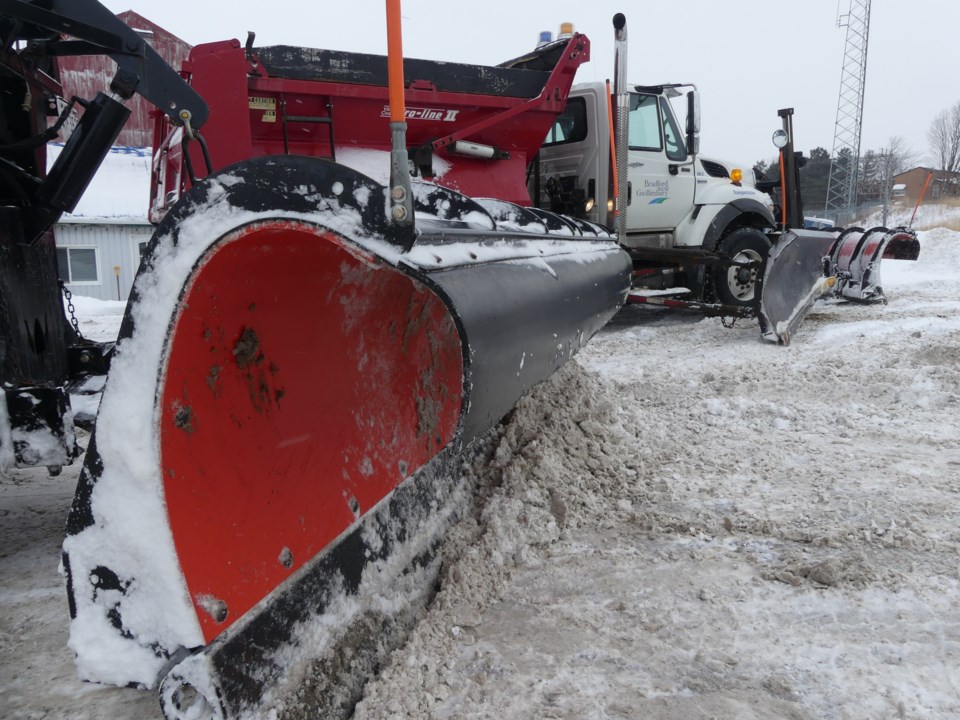BRADFORD - Sand? Salt? Some alternative mix?
With winter weather falling upon Bradford West Gwillimbury and Innisfil, choosing the best substance to apply to roads, sidewalks and parking lots throughout the area is a literal science. That’s especially complicated by the need to reduce salt usage, where possible, due to the harmful long-term effects it can have on the Lake Simcoe watershed.
“This is worth flagging at least once a year, to remind folks it’s an issue,” Lake Simcoe Region Conservation Authority (LSRCA) watershed plans and strategies manager Bill Thompson said. “It’s a mixed bag — we’re doing better in some ways and experiencing new challenges in other ways. Municipalities are continuing to refine how they manage roads.”
A survey completed last year by the LSRCA found watershed municipalities are all decreasing application rates — the amount of salt they put down per kilometre. However, that is negated somewhat by the fact they’re hitting roads more often as yearly weather patterns get “dicier,” he said.
“(Application is) the one thing roads staff have control over,” Thompson said. “They can’t control how many roads or winter events there are, but they can control how much salt goes into the back end of their truck. They’re doing a really great job on that. The challenge is there are a lot more people moving into the watershed, (and) roads (and parking lots) are being built to support that. The other piece is weather: We’re certainly seeing the effects of climate change and our winters are getting a lot more messy and unpredictable.”
Since 1971, the average chloride concentration in the lake has increased by about .7 milligrams per litre annually. If this pace keeps up, the lake will exceed the Canadian government’s chronic (long-term) chloride guidelines within the next century.
“It’s on the horizon; when you look at the trend, it’s steadily going up,” Thompson said. “At some point, we’re going to hit that tipping point. I’m reluctant to put a number on it. But somewhere between 50 and a hundred years from now, we’re going to find ourselves in that situation where the ecosystem, the food web in the lake, is going to be impacted. Another 50 to 100 years beyond that, you’re not going to be able to use the lake as a source of drinking water anymore. I’d like to leave the lake in a better situation than I found it. We’re hoping we can avoid that tipping point.”
He estimates more than 100,000 tons of salt is applied to paved surfaces within the watershed annually. A good amount of that finds its way into creeks and rivers before hitting the lake, and the LSRCA is seeing concentration increasing in tributaries throughout southern Simcoe County, he said.
“Everything is trending upward,” Thompson said.
Bradford transportation manager Joe Coleman notes the municipality is “continually" balancing limiting salt usage and environmental impact with maintaining safe roads and sidewalks for residents and commuters.
“A very critical part ... is to apply at proper times to be the most effective,” he said. “This process eliminates multiple unneeded passes and ensures that previous salt applications are not being removed. We are committed to ensuring proper salt application and have consistently followed the practice of plowing roads and sidewalks whenever possible. Salt is a very effective winter control. However, using it responsibly is something always top of mind at BWG.”
By clearing away accumulated snow, salt can work more efficiently on roads with a lower spread rate, Coleman said.

Bradford plows feature two-stage blades equipped with individual cutting edges that provide a second level of snow clearing, with the truck only having to do one pass.
“They are known in the industry as ‘salt savers,’ that in proper conditions can achieve an almost bare pavement condition, requiring less need for salt application,” Coleman said. “Snow removal equipment is also equipped with electronic spreader controls that are tracked and monitored through our GPS system, giving us spread rates and accumulating totals. Spreader units are calibrated and verified each fall. Each time a truck is repaired, that could affect the calibration settings.”
Staff also undergo training at the “Snow School” offered by the Ontario Good Roads Association, as well as preseason winter orientation, with a focus on collaboration to reduce salt usage, implementation of proper clearing practices, and delivery of “exceptional service,” he said.
Meanwhile, Innisfil operations director Nicole Bowman says the town applies salt on main roads and pickled sand on secondary routes.
“Before applying, we consider both the current and anticipated weather conditions including the forecasted snow accumulation,” she said. “Our crews patrol the roads day and night during winter, constantly assessing conditions. Especially at this time of year when the conditions are right, we will apply anti-ice (salt brine) on dry asphalt to help prevent ice from forming. We are aware that salt and sand may impact lakes and waterways and strive to strike a balance between road safety and environmental sustainability.”
But what is the Ontario government doing to promote the local curbing of road salt? Since 2018, under the Great Lakes and Lake Simcoe programs, the province has spent more than $1.4 million on 11 projects that address chloride monitoring and excess road salt. Projects aim to better understand chloride toxicity, patterns and contributions from urbanized watersheds, groundwater conveyance, and the influence of stormwater measures. Some also encourage the adoption of sustainable salt management practices on private parking lots, roads and sidewalks, said Gary Wheeler, spokesperson for the Ministry of the Environment, Conservation and Parks.
Since 2013, the province has also supported the Smart About Salt Council to modernize a winter maintenance professional certification program, including training for contractors about the use of best management practices.
“The Ontario government is committed to protecting our lakes, rivers and groundwater resources, now and for future generations,” Wheeler said. “We work with conservation authorities, the winter maintenance sector, and road authorities like municipalities and the Ontario Ministry of Transportation (MTO) to promote the responsible use of road salt, operator training and certification, and road salt alternatives.”
The MTO manages road salt on provincial highways to “ensure the safety of the travelling public,” and it has an established application plan in place, in accordance with federal regulations, he said.
While usage can be reduced, there’s no feasible alternative available, and salt application still plays a key role in keeping paved surfaces safe during cold weather.
“The challenge for the lake is still a very real challenge, unfortunately,” Thompson said. “There’s no silver bullet. It’s an interesting challenge because there’s no obvious solution to it.”
More details on Innisfil’s snow-clearing plan, including a link to a plow tracker, can be found at innisfil.ca. Further information on Bradford’s service is at townofbwg.com.
